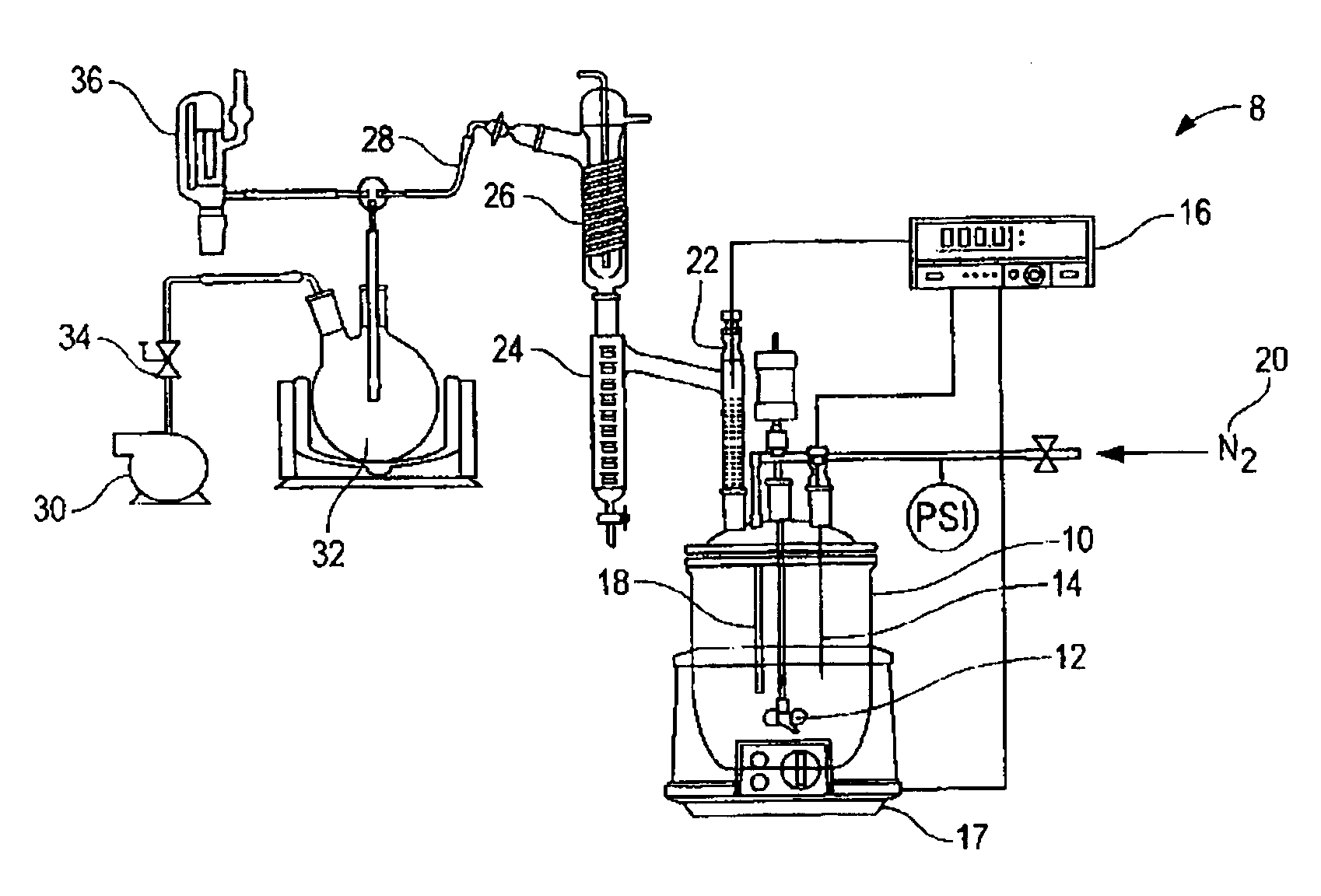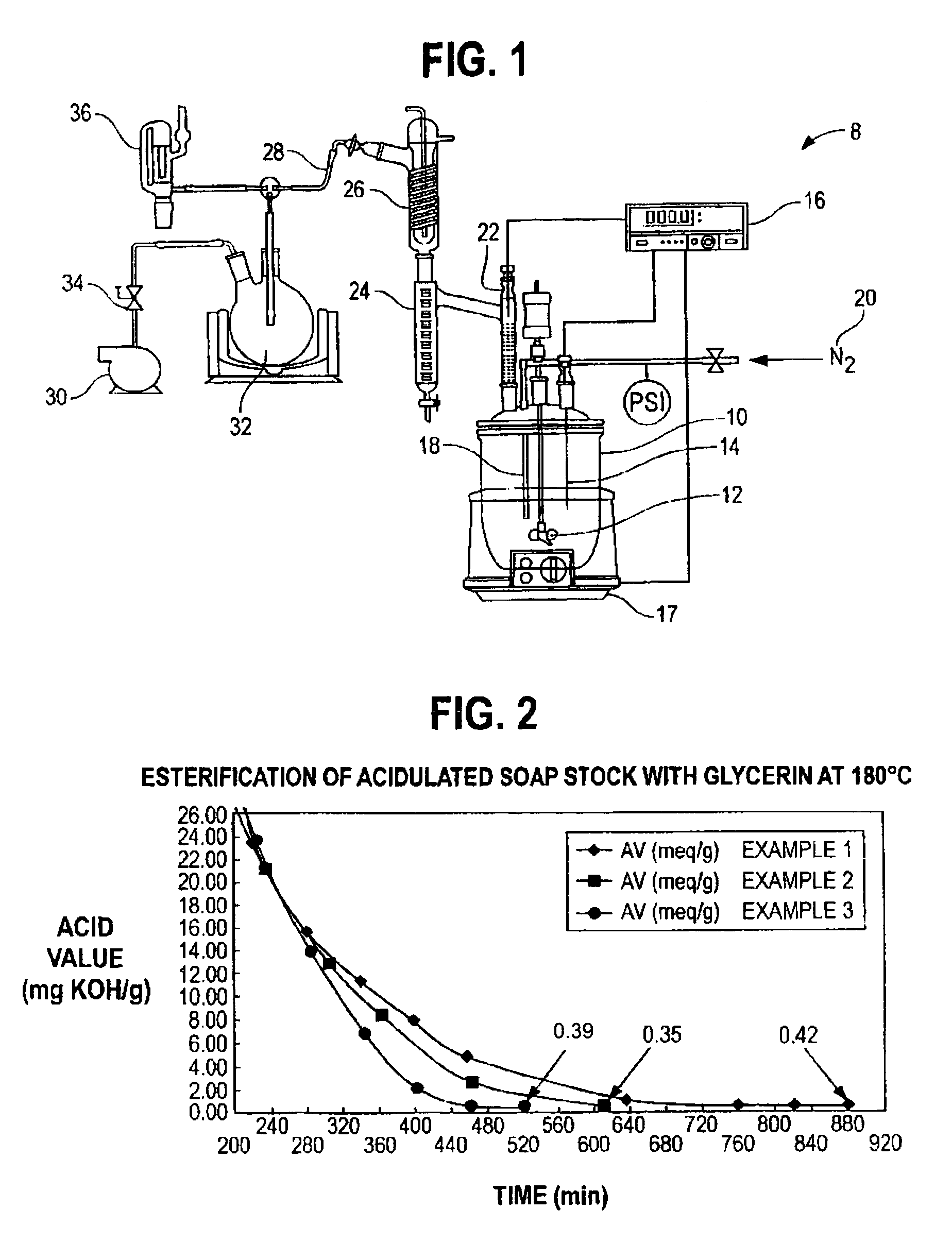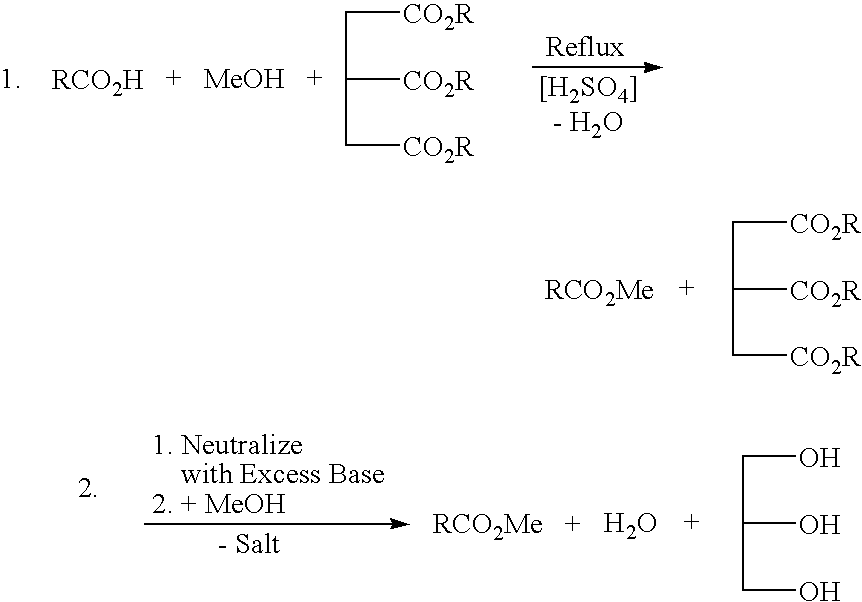Method of making alkyl esters using glycerin
a technology of glycerin and alkyl esters, which is applied in the preparation of carboxylic compounds, biofuels, organic chemistry, etc., can solve the problems of long cycle time, cumbersome recovery scheme of residual free fatty acids, and need to separate methanol from water for recovery and/or waste disposal, so as to reduce or eliminate salt and aqueous waste
- Summary
- Abstract
- Description
- Claims
- Application Information
AI Technical Summary
Benefits of technology
Problems solved by technology
Method used
Image
Examples
example 1
[0029]549 g of acidulated soap stock and 108 g of USP grade glycerin were charged into a 1L resin kettle 10 (FIG. 1). The reaction setup 8 of FIG. 1 was used. The resin kettle 10 was heated to the reaction temperature of 180° C. over a period of 60 minutes at atmospheric pressure. After approximately 65 minutes from the time of heat input, vacuum was applied in stages over time to reduce pressure, as reported in Table 1, to assist in the removal of reaction water. A stream of nitrogen was applied in addition to vacuum after 340 minutes of reaction time (as measured from the start of heat input). Samples were taken intermittently to monitor the reaction progress. The reaction was complete (AV=<0.5) after approximately 880 minutes. The collected distillate was measured to 26.11 g, including a thin layer on top of the reaction water, composed of light (C6–C8) fatty acids. The total recovered mass of glyceride mixture was 622.67 g.
[0030]Table 1 sets forth the reaction parameters and mea...
example 2
[0032]583.9 g of acidulated soap stock and 135.97 g crude glycerin (containing 86% glycerin, and the balance as water, methanol and residual base catalyst), derived from the methanolysis of soybean oil, was charged into a 1 L resin kettle 10 (FIG. 1). The reaction setup 8 of FIG. 1 was used. The pH of the combined materials, as a 10% suspension in a 50 / 50 mixture by volume of isopropanol and water, was measured to 5.34. The mixture was heated to reaction temperature of 180° C. and vacuum was applied in conjunction with a nitrogen sparge to facilitate the removal of reaction water, as reported in Table 2. The total amount of distillate, including methanol and reaction water, as well as approximately 3.5 ml low molecular weight fatty acids, was measured to 58.58 g. The recovered weight of glycerides was 654.68 g (90.9% based on total mass input). In general, this example shows that by using the crude glycerin, the duration of vacuum application in combination with nitrogen sparging ma...
example 3
[0035]Example 3 demonstrates that by utilizing the combination of vacuum and nitrogen sparge earlier in the process, cycle time can be reduced further, without negatively affecting the final product, e.g., by removing raw material from the reactor resulting in decreased yields. 528.5 g of acidulated soap stock were combined with 124.4 g of crude glycerin and processed as under example 1–2. The pH of the reaction mixture immediately after combing the raw materials was measured to 5.04. The total weight of distillate was measured to 54.77 g and the isolated yield of glycerides was 589.68 g (90.3% based on total mass input).
[0036]Table 3 sets forth the reaction parameters and measured acid values of Example 3 demonstrating the progress of the conversion of the free fatty acids of the soap stock sample into glycerides.
[0037]
TABLE 3Reaction parameters for Example 3.TimeReactorPressureml 0.1 NAVN2[min][° C.][torr]Sample [g]NaOH[meq / g]Purge020.4760104.20no1571.4760no30111.2760no35121.0760n...
PUM
| Property | Measurement | Unit |
|---|---|---|
| pressure | aaaaa | aaaaa |
| pressure | aaaaa | aaaaa |
| pressure | aaaaa | aaaaa |
Abstract
Description
Claims
Application Information
 Login to View More
Login to View More - R&D
- Intellectual Property
- Life Sciences
- Materials
- Tech Scout
- Unparalleled Data Quality
- Higher Quality Content
- 60% Fewer Hallucinations
Browse by: Latest US Patents, China's latest patents, Technical Efficacy Thesaurus, Application Domain, Technology Topic, Popular Technical Reports.
© 2025 PatSnap. All rights reserved.Legal|Privacy policy|Modern Slavery Act Transparency Statement|Sitemap|About US| Contact US: help@patsnap.com



